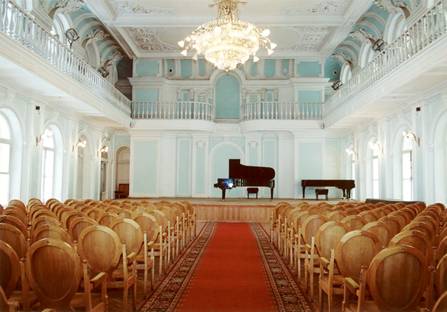

The Rachmaninoff Hall. 2000s. Photo by V. N. Kraynov
The Third Tutorial Building of the Moscow Conservatory is situated on Bolshaya Nikitskaya Street 11, and is an outstanding architectural landmark from the late 18th century. It was constructed on a piece of land which long before then belonged to a noble family of boyars, the Kolychevs.
The architect who designed the building came from the school of the famous Russian architect Matvey Feodorovich Kazakov (1738–1813). From the late 19th century the building housed the Synod College for Church Singing. In 1898 the concert hall was built, which was distinguished for the beauty of its interior and magnificent acoustics (architect – Vladimir Dmitrievich Scher).
And prior to that – in 1886 – the college obtained the status of a secondary educational institution, and an Advisory Board was created as part of it, which included such remarkable Russian musicians as Pyotr Il’ich Tchaikovsky (1840–1893), Sergey Ivanovich Taneyev (1856–1915), Antony Stepanovich Arensky (1861–1906), and Vasily Il’ich Safonov (1852–1918).
Among the outstanding contributors to the Russian musical culture was the director of the Synod College for Church Singing Stepan Vasil’yevich Smolensky (1848–1909), who collected a unique library of vocal manuscripts, and the conductor of the Synod Choir, the director of the college Aleksandr Dmitrievich Kastalsky (1856–1926), who in 1918 became the head of the Moscow People’s Choral Academy, created on the foundation of the Synod College. In 1923 the Academy was incorporated into the Moscow Conservatory, forming the Department for Choral Conducting, and Kastalsky became its head and a leading professor in it.
Unfortunately, fate ordained that the Conservatory was bereft for a few decades of one of its marvelous buildings: in 1925 it was taken up by the Institute of Law, which after the war was subsumed into the Law Department of the Moscow State University.
Upon the order of the Council of Ministers of the USSR issued in August 1968, building N.11 on Herzen Street (which was how Bol’shaya Nikitskaya Street was named at that time) was returned to the Moscow Conservatory. However, because at the Moscow University on Vorobyovy Hills (which at that time were called the Lenin Hills) the construction of the new building for the Law Department was greatly delayed, the Moscow Conservatory got back its Third Building only in August 1979. Classes began immediately after that, but in 1980 they were stopped due to repairs administered on the building, and were resumed only in 1982.
The concert hall of 252 seats on the second floor of the building, opened after its restoration on June 1, 1983 with a recital of the celebrated pianist Svyatoslav Teofilovich Richter (1915–1997), has always been a special favorite for performers and concert-goers.
Since 1986 this hall has been called the Rachmaninoff Hall, because many pages of the outstanding Russian composer, pianist and conductor Sergey Vasil’yevich Rachmaninoff (1873–1943) were connected with the Moscow Conservatory and the Synod College for Church Singing.
Another extremely popular venue is the comfortable Conference Hall, which is situated across from the Rachmaninoff Hall. It has been used for organizing conferences related to musicology and music theory, some of them being international, as well as concerts, master classes and meetings with outstanding musicians. In addition, each month a series of concerts, called “Gatherings in the Musial Salon” are organized here. They were initiated in 2001 by rector of the Moscow Conservatory Aleksandr Sergeyevich Sokolov.
In the foyer in front of the Conference Hall there is a portrait sculpture of Sergey Vasil’yevich Rachmaninoff, made by Viktor Ivanovich Dudnik (1935–2010).
By the decision of the Advisory Board of the Moscow Conservatory from November 28 2006, the entire Third Tutorial Building, similarly to the concert hall, was given the name of Sergey Vasil’yevich Rachmaninoff.